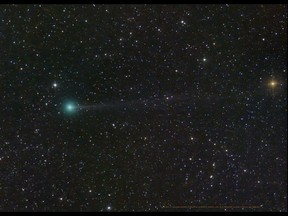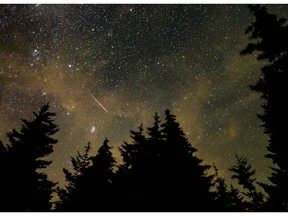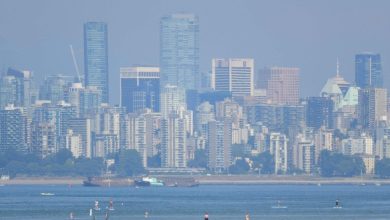Comet Nishimura: A once-in-a-400-year chance to see it from Vancouver

The comet, which will be closest to Earth on Tuesday, should be visible as a small streak near Venus but it won’t be easy to see from Metro Vancouver.

Article content
A newly discovered comet will pass closest to Earth on Tuesday, offering a once-in-a-lifetime viewing opportunity — and you won’t even need a telescope.
Comet Nishimura was discovered by amateur astronomer Hideo Nishimura while photographing the night sky in Japan on Aug. 11 and 12. It has an estimated orbit of more than 400 years, meaning it won’t pass by Earth again until sometime in the 25th century.
Advertisement 2
Article content
Article content
Article content
Advertisement 3
Article content
How to see Comet Nishimura
To see Comet Nishimura, find a location where you can see the eastern horizon without trees or other obstructions. A mountain top view, away from the lights of the city and with a clear eastern view is ideal.
The comet should be visible as a small streak near Venus.
Nishimura should be visible with binoculars or a telescope in the eastern sky before dawn on clear days, according to Alan Jones, president of the Vancouver chapter of the Royal Astronomical Society of Canada. He cautioned that catching sight of the comet would be difficult, however.
“Our location is not great for this particular comet,” he said. “You could see it in binoculars potentially if you have a nice clear sky but it’s very low on the eastern horizon before sunrise.”
The comet will reach its closest point to Earth on Sept. 12 and then to the sun on Sept. 17. Jones said as it approaches the sun, it will be “pretty much impossible to see because the Sun’s brightness outshines it so much.”
Advertisement 4
Article content
What do we know about the comet
Comet Nishimura — formally named C/2023 P1 — is the third comet Hidea Nishimura discovered. He previously discovered Comet Nakamura-Nishimura-Machholz (C/1994 N1) and Comet Nishimura (C/2021 O1).
It’s uncommon for individuals to discover new comets anymore. Most are now found by automated telescopes operated by professionally run observatories.
Nishimura captured the first images of the comet while taking a long-exposure photograph of the sky with a Canon digital camera and telephoto lens. At its closest point on Sept. 12, the comet will pass 125 million kilometres from Earth. Five days later it will pass 43 million kilometres from the sun — its closest approach before continuing its journey away from the sun.
Meteor showers and other comet facts
Comets, often compared to dirty snowballs, are made up of frozen gases, rock and dust, some of which begins to vaporize as the comet’s orbit brings it close to the hot sun, creating the trademark comet tails.
Comets also typically have green heads, possibly caused by highly reactive molecules getting blown apart by sunlight, though the colour never extends to the tails.
Advertisement 5
Article content
Advertisement 6
Article content
The orbits of comets can be affected by other bodies in the solar system, like planets or moons, which can sometimes bring them too close to the sun, destroying them.
“That’s what happened with the Perseids,” Jones said, referring to the now-famous meteor shower that takes place each year from mid-July to late August.
“There was a comet that came in towards the sun and it came too close and was blown apart,” Jones said. “When we see the Perseids, we’re actually going through the debris from a comet from years and years ago.”

-

Black hole photo gets a makeover: ‘fuzzy doughnut’ now ‘skinny doughnut’
-
Was the big bang the beginning of everything? Or was there a sequel?
More news, fewer ads, faster load time: Get unlimited, ad-lite access to The Vancouver Sun, The Province, National Post and 13 other Canadian news sites for just $14/month or $140/year. Subscribe now through The Vancouver Sun or The Province.





Comments
Postmedia is committed to maintaining a lively but civil forum for discussion and encourage all readers to share their views on our articles. Comments may take up to an hour for moderation before appearing on the site. We ask you to keep your comments relevant and respectful. We have enabled email notifications—you will now receive an email if you receive a reply to your comment, there is an update to a comment thread you follow or if a user you follow comments. Visit our Community Guidelines for more information and details on how to adjust your email settings.
Join the Conversation